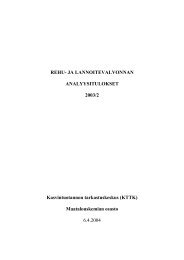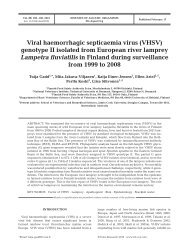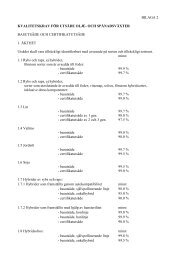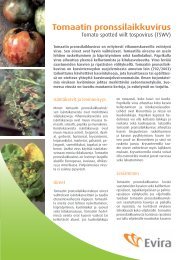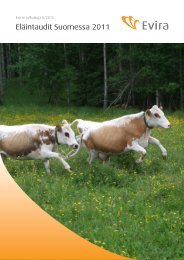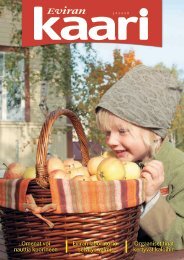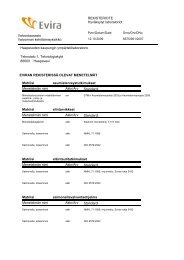Genetic characteristics of field and attenuated rabies viruses ... - Evira
Genetic characteristics of field and attenuated rabies viruses ... - Evira
Genetic characteristics of field and attenuated rabies viruses ... - Evira
You also want an ePaper? Increase the reach of your titles
YUMPU automatically turns print PDFs into web optimized ePapers that Google loves.
Nadin-Davis et al., 2001, 2003; Favoretto et al., 2002).<br />
Most <strong>of</strong> the <strong>rabies</strong> cases in terrestrial animals <strong>and</strong> human beings are due to the<br />
genotype 1 <strong>viruses</strong>, but some cases are caused by <strong>viruses</strong> from other genotypes. Spillover<br />
<strong>of</strong> the EBLV1 virus into the stone marten (Martes foina) under natural conditions has<br />
been recorded in Germany (Muller et al., 2004). Also in 1998 cases <strong>of</strong> <strong>rabies</strong> in sheep<br />
that were shown to have been infected with the EBLV-1a possibly derived from<br />
insectivorous bats were observed in Denmark (Stougaard <strong>and</strong> Ammendrup, 1998), <strong>and</strong> in<br />
2002, a second occurrence <strong>of</strong> the EBLV-type 1 in sheep was reported (Ronsholt, 2002).<br />
Also, several human cases caused by EBLVs <strong>and</strong> ABLV strains have been reported in<br />
some European countries <strong>and</strong> in Australia (Lumio et al., 1986; McColl et al., 2000; Fooks<br />
et al., 2003; Spooner, 2003).<br />
One <strong>of</strong> the most important issues in the <strong>field</strong> <strong>of</strong> <strong>rabies</strong> research is the identification<br />
<strong>and</strong> characterization <strong>of</strong> new genotypes. Due to PCR <strong>and</strong> nucleotide sequencing during<br />
the last ten years, one new genotype has been identified <strong>and</strong> four additional were<br />
proposed. Fraser et al. (1996) isolated a new Lyssavirus from bats in Australia, which was<br />
later identified by nucleotide sequencing as the new seventh genotype: Australian bat<br />
Lyssavirus or ABLV (Gould et al., 1998). The phylogenetic analysis <strong>of</strong> the ABLV <strong>viruses</strong><br />
has shown that they form a monophyletic group distinct from the other Lyssa<strong>viruses</strong>, <strong>and</strong><br />
two antigenic variants <strong>of</strong> ABLV were described (Guyatt et al., 2003). Arai et al., (2003)<br />
studied <strong>rabies</strong> virus isolated from the Lesser Mouse-eared Bat (Myotis blythi) in<br />
Kyrgyzstan <strong>and</strong> have suggested that it belonged to a new genotype <strong>of</strong> the <strong>rabies</strong> virus<br />
(Aravan virus). Furthermore, the Khuj<strong>and</strong> virus isolated from northern Tajikistan in 2001<br />
can be classified as a separate genotype <strong>of</strong> Lyssavirus (Kuzmin et al., 2003). Two unique<br />
<strong>viruses</strong> (Irkut <strong>and</strong> West Caucasian) have been isolated from bats in Russia <strong>and</strong> based on<br />
genetic studies it has been suggested that they belong to new genotypes (Botvinkin et al.,<br />
2003; Kuzmin et al., 2005).<br />
1.7.3. Entire genome sequencing <strong>of</strong> vaccine strains<br />
The entire genome sequencing <strong>of</strong> the vaccine strains provides important data<br />
relative to the <strong>rabies</strong> virus genome <strong>and</strong> allows its antigenic, genetic, <strong>and</strong> immunogenic<br />
properties to be predicted <strong>and</strong> analyzed. To conduct complete sequencing <strong>of</strong> the <strong>rabies</strong><br />
virus genome, several techniques can be employed. Tordo et al. (1986, 1988) used<br />
cloning in plasmid vector pBR322 <strong>and</strong> sequence determination by the chain-terminating<br />
inhibitor method after inserting endonuclease restriction fragments <strong>of</strong> the cDNA inserts<br />
33



